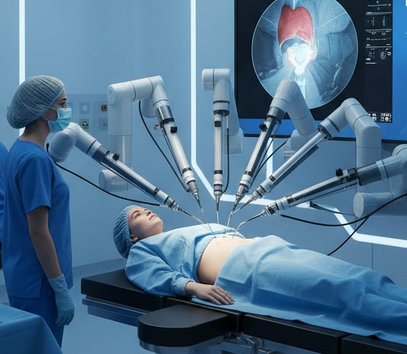Treatment Overview
Diagnostic laparoscopy is a minimally invasive surgical procedure used to examine the pelvic organs and tissues directly. It allows gynecologists to view the uterus, ovaries, fallopian tubes, and surrounding structures in real time, identifying the exact cause of pelvic pain.
In Korea, diagnostic laparoscopy is an essential part of pelvic pain evaluation and women’s health care. It is regarded as one of the most precise diagnostic tools for conditions such as endometriosis, pelvic inflammatory disease, adhesions, ovarian cysts, and unexplained chronic pelvic pain. By combining cutting-edge laparoscopic technology with expert surgical skill, Korean hospitals ensure accurate diagnosis and effective treatment planning.
This procedure not only helps in diagnosing but often allows for simultaneous treatment of identified issues during the same surgical session. This dual diagnostic and therapeutic approach is a major reason why Korea is a leading destination for gynecologic laparoscopy.
Purpose & Benefits
The purpose of diagnostic laparoscopy is to directly inspect pelvic organs when other non-invasive methods such as ultrasound or MRI do not provide definitive answers. Benefits of this procedure include:
- Precise diagnosis: Direct visualization of internal organs with magnified imaging.
- Minimally invasive: Small incisions reduce recovery time and minimize pain.
- Simultaneous treatment: Surgeons can address abnormalities during the same procedure.
- Early detection: Conditions like endometriosis and early-stage pelvic tumors can be diagnosed sooner.
Korean hospitals use advanced laparoscopic systems that provide ultra-high-definition images, improving accuracy and reducing diagnostic time.
Ideal Candidates
Diagnostic laparoscopy is recommended for women who:
- Experience chronic or unexplained pelvic pain.
- Have suspected endometriosis or pelvic adhesions.
- Show inconclusive results from other imaging tests.
- Require evaluation before infertility treatment.
- Have recurrent pelvic inflammatory disease or ovarian cysts.
Korean specialists also offer this procedure for international patients seeking precise evaluation combined with high-quality care.
Possible Risks & Complications
Diagnostic laparoscopy is generally safe, but as with any surgical procedure, it carries potential risks such as:
- Minor bleeding or infection at incision sites.
- Temporary discomfort or bloating after surgery.
- Risks related to general anesthesia.
- Injury to surrounding organs or blood vessels (rare).
Korean surgical centers follow rigorous safety protocols and employ advanced surgical tools to minimize these risks. Preoperative evaluations and postoperative monitoring ensure optimal patient safety.
Surgical Techniques Used
Korea is recognized globally for its advanced laparoscopic techniques. Commonly used methods for pelvic pain evaluation include:
- High-definition laparoscopy: Provides clear and magnified views of pelvic organs.
- Single-incision laparoscopic surgery (SILS): Minimizes scarring by using one small incision.
- Robotic-assisted laparoscopy: Offers enhanced precision and dexterity.
- Fluorescence-guided laparoscopy: Uses special dyes to highlight abnormal tissue for more accurate diagnosis.
These advanced techniques allow Korean surgeons to perform comprehensive pelvic evaluations with minimal discomfort and faster recovery.
Recovery & Aftercare
Recovery from diagnostic laparoscopy is generally quick. Most patients can resume light activities within a few days and return to normal routines within one to two weeks. Aftercare typically includes:
- Rest and avoidance of strenuous activities for a short period.
- Pain management with prescribed medication.
- Monitoring for signs of infection or complications.
- Follow-up consultations to discuss findings and treatment plans.
Korean hospitals provide detailed postoperative instructions and often offer follow-up imaging or evaluations to ensure optimal healing and results.
Results & Longevity
Diagnostic laparoscopy offers highly reliable results. Surgeons can identify conditions that are difficult to detect with imaging alone. When combined with simultaneous treatment, patients often experience immediate relief of symptoms and improved long-term outcomes.
Findings from laparoscopy also guide personalized treatment plans, ensuring more effective management of chronic pelvic pain and related conditions. Results from this procedure often remain relevant for years, especially when treatment is provided during the same surgical session.
Treatment Process in Korea
The process of diagnostic laparoscopy in Korea is streamlined and patient-focused:
- Consultation & Preoperative Evaluation: Includes medical history review, physical examination, and imaging tests.
- Preparation: Patients receive preoperative instructions and anesthesia assessment.
- Surgical Procedure: Small incisions are made, and laparoscopic instruments are inserted for examination. Any abnormalities can be treated simultaneously.
- Postoperative Care: Patients are monitored for complications and receive aftercare guidance.
- Follow-Up: Surgeons review findings and recommend additional treatments if necessary.
Korea’s excellence in laparoscopy comes from combining high surgical skill with modern technology, such as robotic-assisted systems and advanced imaging. This makes Korea a preferred destination for women seeking precise pelvic pain evaluation.
Cost Range
The cost of diagnostic laparoscopy in Korea depends on the complexity of the procedure and the facility:
- Basic diagnostic laparoscopy: ₩2,000,000–₩3,500,000 KRW ($1,500–$2,700 USD).
- Laparoscopy with simultaneous treatment: ₩3,500,000–₩6,000,000 KRW ($2,700–$4,500 USD).
- Robotic-assisted laparoscopy: ₩5,000,000–₩8,000,000 KRW ($3,800–$6,100 USD).
Many hospitals offer package deals that include preoperative consultations, the procedure, anesthesia, and postoperative care.
Popular Clinics in Korea
- Samsung Medical Center — Known for advanced gynecologic laparoscopy and robotic surgery.
- Asan Medical Center — Offers comprehensive pelvic pain evaluation with state-of-the-art facilities.
- CHA Bundang Women’s Hospital — Specialized in minimally invasive gynecologic surgery.
- Severance Hospital, Yonsei University — Renowned for precision laparoscopy and pelvic pain management.
- Kyung Hee University Medical Center — Integrates high-definition laparoscopy with multidisciplinary care.




